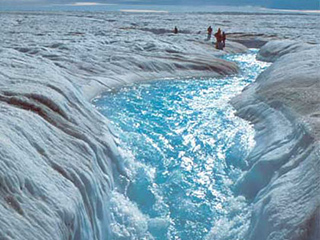GLOBAL WARMING? NASA says Antarctic has been COOLING for past SIX years
ANTARCTIC temperatures have cooled over the past six years, according to US space agency NASA.
07:51, Sat, Nov 28, 2015 | UPDATED: 12:58, Sat, Nov 28, 2015

NASA

NASA
Map showing the extent of ice during the NASA studiesRead More Here
.......................................................................................
Examiner.com
New paper claims no pause in warming, but unaltered data says otherwise

Photo by Aaron Harris
Environmental activists have plundered Nature's Scientific Reports and released
a paper yesterday that they claim removes all doubt there is a global
warming pause. After examining 40 peer-reviewed papers that show a
global warming hiatus, they claim the papers didn't examine a long
enough period of time. In fact, the authors—Stephan Lewandowsky, James
Risbey, and Naomi Oreskes—broke the golden rule of science: they started
with a predetermined outcome and then cherry-picked the data to fit
their conclusion. It also runs counter to the unaltered datasets from
leading climate institutions.
The paper assessed the "magnitude and significance of all possible trends up to 25 years duration looking backwards from each year over the past 30 years." Unsurprisingly, the authors thought the papers didn't use a long enough time frame to show a clear global warming pause over the entire global warming "record." Here we document how this extended global warming record has been tampered, altered, and utilized for politicized "green ideology," and how massive alterations were made to both NASA and NOAA's temperature data series.
According to the satellite record (the most accurate), weather balloons, radiosonde data, sea surface temperatures, and weather stations (least accurate), previously unadulterated data from the National Oceanic and Atmospheric Administration (NOAA) and the National Aeronautics and Space Administration Goddard Institute of Space Studies (NASA GISS) data showed a long-term definitive trend: no increase in tropospheric temperatures when the Industrial Revolution began in earnest after World War II.
We do have weather station temperature data, albeit spotty, that goes back to 1881 and it shows regular intervals of warming and cooling, and not the popular upward slope in temperatures used by environmentalists and governments to illustrate dramatic global warming. More on that shortly.
The paper assessed the "magnitude and significance of all possible trends up to 25 years duration looking backwards from each year over the past 30 years." Unsurprisingly, the authors thought the papers didn't use a long enough time frame to show a clear global warming pause over the entire global warming "record." Here we document how this extended global warming record has been tampered, altered, and utilized for politicized "green ideology," and how massive alterations were made to both NASA and NOAA's temperature data series.
According to the satellite record (the most accurate), weather balloons, radiosonde data, sea surface temperatures, and weather stations (least accurate), previously unadulterated data from the National Oceanic and Atmospheric Administration (NOAA) and the National Aeronautics and Space Administration Goddard Institute of Space Studies (NASA GISS) data showed a long-term definitive trend: no increase in tropospheric temperatures when the Industrial Revolution began in earnest after World War II.
We do have weather station temperature data, albeit spotty, that goes back to 1881 and it shows regular intervals of warming and cooling, and not the popular upward slope in temperatures used by environmentalists and governments to illustrate dramatic global warming. More on that shortly.
Read More Here
Next: How NOAA rewrote climate data to hide global warming pause
...................................................................................................
Nasa Earth Observatory
Earth is Cooling…No It’s Warming
In
1967 Hansen went to work for NASA’s Goddard Institute for Space
Studies, in New York City, where he continued his research on planetary
problems. Around 1970, some scientists suspected Earth was entering a
period of global cooling. Decades prior, the brilliant Serbian
mathematician Milutin Milankovitch
had explained how our world warms and cools on roughly 100,000-year
cycles due to its slowly changing position relative to the Sun.
Milankovitch’s theory suggested Earth should be just beginning to head
into its next ice age cycle. The surface temperature data gathered by
Mitchell seemed to agree; the record showed that Earth experienced a
period of cooling (by about 0.3°C) from 1940 through 1970. Of course,
Mitchell was only collecting data over a fraction of the Northern
Hemisphere—from 20 to 90 degrees North latitude. Still, the result drew
public attention and a number of speculative articles about Earth’s
coming ice age appeared in newspapers and magazines.

Initial
efforts to observe Earth’s temperature were limited to the Northern
Hemisphere, and they showed a cooling trend from 1940 to 1970 (jagged
line). Scientists estimated the relative effects of carbon dioxide
(warming, top curve) and aerosols (cooling, bottom curve) on climate,
but did not have enough data to make precise predictions. (Graph from
Mitchell, 1972.)
But other scientists forecasted
global warming. Russian climatologist Mikhail Budyko had also observed
the three-decade cooling trend. Nevertheless, he published a paper in
1967 in which he predicted the cooling would soon switch to warming due
to rising human emissions of carbon dioxide. Budyko’s paper and another
paper published in 1975 by Veerabhadran Ramanathan caught Hansen’s
attention. Ramanathan pointed out that human-made chlorofluorocarbons
(or CFCs) are particularly potent greenhouse gases, with as much as 200
times the heat-retaining capacity of carbon dioxide. Because people were
adding CFCs to the lower atmosphere at an increasing rate, Ramanathan
expressed concern that these new gases would eventually add to Earth’s
greenhouse effect and cause our world to warm. (Because CFCs also erode
Earth’s protective ozone layer, their use was mostly abolished in 1989
with the signing of the Montreal Protocol.)
.................................................................................................
Climate change: How do we know?
![This graph, based on the comparison of atmospheric samples contained in ice cores and more recent direct measurements, provides evidence that atmospheric CO2 has increased since the Industrial Revolution. (Source: [[LINK||http://www.ncdc.noaa.gov/paleo/icecore/||NOAA]])](http://climate.nasa.gov/system/content_pages/main_images/203_co2-graph-080315.jpg)
The
Earth's climate has changed throughout history. Just in the last
650,000 years there have been seven cycles of glacial advance and
retreat, with the abrupt end of the last ice age about 7,000 years ago
marking the beginning of the modern climate era — and of human
civilization. Most of these climate changes are attributed to very small
variations in Earth’s orbit that change the amount of solar energy our
planet receives.
The current warming trend is of particular significance because most of it is very likely human-induced and proceeding at a rate that is unprecedented in the past 1,300 years.1
Earth-orbiting satellites and other technological advances have enabled scientists to see the big picture, collecting many different types of information about our planet and its climate on a global scale. This body of data, collected over many years, reveals the signals of a changing climate.
Read More HereScientific evidence for warming of the climate system is unequivocal.
The current warming trend is of particular significance because most of it is very likely human-induced and proceeding at a rate that is unprecedented in the past 1,300 years.1
Earth-orbiting satellites and other technological advances have enabled scientists to see the big picture, collecting many different types of information about our planet and its climate on a global scale. This body of data, collected over many years, reveals the signals of a changing climate.
The evidence for rapid climate change is compelling:

Global temperature rise
All three major global surface temperature reconstructions show that Earth has warmed since 1880.5 Most of this warming has occurred since the 1970s, with the 20 warmest years having occurred since 1981 and with all 10 of the warmest years occurring in the past 12 years.6 Even though the 2000s witnessed a solar output decline resulting in an unusually deep solar minimum in 2007-2009, surface temperatures continue to increase.7+ expand

Flowing meltwater from the Greenland ice sheetShrinking ice sheets
The Greenland and Antarctic ice sheets have decreased in mass. Data from NASA's Gravity Recovery and Climate Experiment show Greenland lost 150 to 250 cubic kilometers (36 to 60 cubic miles) of ice per year between 2002 and 2006, while Antarctica lost about 152 cubic kilometers (36 cubic miles) of ice between 2002 and 2005.+ expand



No comments:
Post a Comment
Hello and thank you for visiting my blog. Please share your thoughts and leave a comment :)